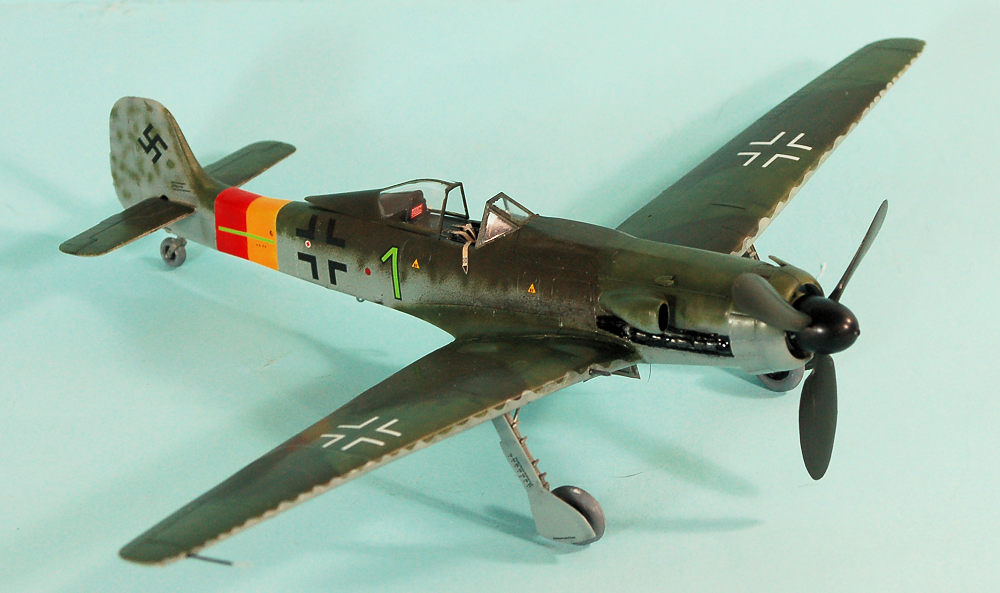
Dragon 1/48 Ta-152H-0
| KIT #: | 5539 |
| PRICE: | $24.95 at estate sale |
| DECALS: | Two options |
| REVIEWER: | Tom Cleaver |
| NOTES: | Special release for Dragon Expo 2008 |

| HISTORY |
The Ta 152 series were Kurt Tank’s attempt to solve the problem that the Fw-190, both the A series and the D sub-types, suffered loss of performance above 25,000 feet. Tank tried it two different ways, following a long development process with experimental Fw 190 sub-types testing power plants, injection methods, supercharging, and aerodynamic properties. There were two principal design avenues. The first was the Ta 152C, which was essentially a FW-190D with a Daimler-Benz DB-603LA engine, while the second was the Ta 152H high-altitude fighter, powered by the Junkers Jumo 213 E and using a long-span high aspect ratio wing.
Unlike the BV 155, a highly experimental, flying test-bed, Tank’s design of the Ta-152H joined a powerful engine that was already proven in the Fw 190D-9 with an existing airframe tweaked to perform at higher altitudes using extended high aspect ratio wings. The result was a fighter that was faster and more maneuverable than either the P-51 or the P-47. The Ta-152H model had a maximum speed of 472 mph at 41,000 feet.
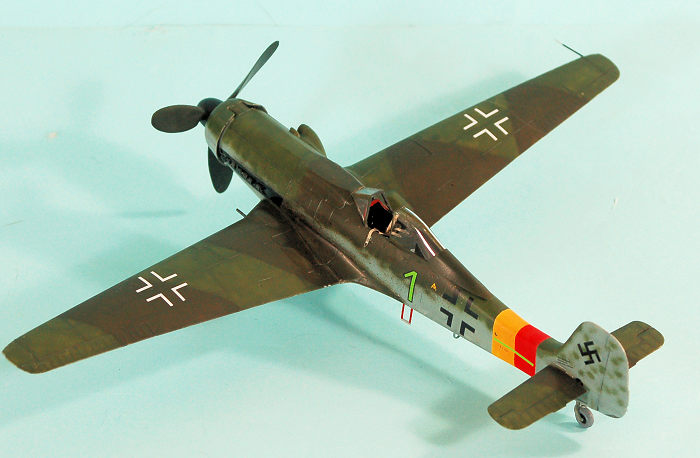 In October and November 1944, 20 pre-production
Ta 152H-0s were delivered to Erprobungskommando Ta 152
at Rechnlin, commanded by Hauptmann
Bruno Stolle. The pressure of events and soundness of the design led him to
recommend a rapid introduction into service, with 20 Ta 152H-1s leaving the
production line at Cottbus in early 1945.
In October and November 1944, 20 pre-production
Ta 152H-0s were delivered to Erprobungskommando Ta 152
at Rechnlin, commanded by Hauptmann
Bruno Stolle. The pressure of events and soundness of the design led him to
recommend a rapid introduction into service, with 20 Ta 152H-1s leaving the
production line at Cottbus in early 1945.
Oberfeldwebel Willi Reschke, who had entered combat on June 20, 1944, with I/JG 302 and scored 17 B-17s and B-24s of 22 victories claimed shot down by early January 1945, was part of the Stabschwarm for JG 301 (I/JG 302 had been redesignated III/JG 301 in September 1944) when he first saw the Ta-152H at the end of January. He recalled:
“On 23 January 1945 Jagdgruppe III./JG 301 was temporarily taken off operations and designated an Einsatzerprobungsverband, a combat test unit. We were to re-equip with the Ta 152. In the early hours of 27 January, we pilots were taken by truck to the Neuhausen aircraft plant near Cottbus with orders to ferry the new Höhenjäger to Alteno. Arriving at the airfield we were confronted with our first sight of the Ta 152 H. which with its enormous wingspan and lengthened engine cowl hardly looked like a fighter aircraft at all. With feelings of unease we walked around the twelve machines. Technicians were on hand to answer our queries. After a talk on the technical aspects of the machines that lasted barely 30 minutes, we took the aircraft on charge. I got airborne at 11:08.”
The pilots of III./JG 301 were eager to try the new fighter in combat. The first combat sortie was flown on 8 February but did not result in contact with the enemy. On 18 February the Geschwader Stabstaffel shifted to Sachau, west of Berlin and encountered US bombers for the first time on 21 February. Oberfeldwebel Josef Keil, flying "Green 3," claimed a B-17 shot down at 1630 over Berlin. On 1 March Keil flew a sortie in the Kommodore's "Green 1" and claimed a P-51 over the same sector. Keil would eventually become the only Ta-152 pilot to claim five victories while flying the new fighter.
On 2 March, the first combat mission was flown by a mixed force of Ta 152Hs and Fw 190As of III./JG 301. A powerful 8th Air Force formation of 1,200 bombers screened by over 700 fighters was dispatched to Böhlen, Magdeburg and Ruhland. Airborne from Sachau behind Oberleutnant Stahl, 12 Ta 152s prepared to intercept the Mustangs screening the bombers heading for the Bohlen chemical plant near Leuna. The sortie ended in disaster when the Ta 152s were engaged. Willi Reschke recalled:
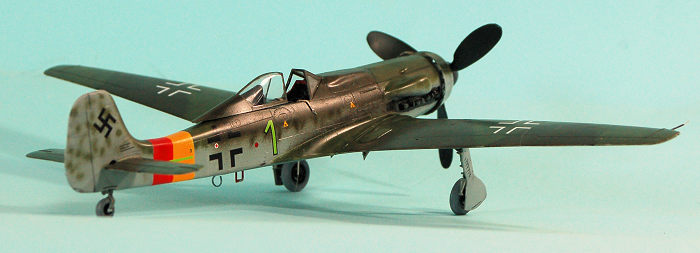 “
We reached grid square Heinrich-Caesar, now flying at an altitude of more
than 8,000 meters and closed to join with Bf-109s from I/JG 301. We could
barely believe our eyes when, moments later, the first tracers split the air
around us as Unteroffizier ’Bubi’
Blum’s Ta 152 came under attack. The 109s had opened up on us! We could
hardly return fire on Kameraden from our own Jagdgeschwader and the sortie
ended in a complete debacle.”
“
We reached grid square Heinrich-Caesar, now flying at an altitude of more
than 8,000 meters and closed to join with Bf-109s from I/JG 301. We could
barely believe our eyes when, moments later, the first tracers split the air
around us as Unteroffizier ’Bubi’
Blum’s Ta 152 came under attack. The 109s had opened up on us! We could
hardly return fire on Kameraden from our own Jagdgeschwader and the sortie
ended in a complete debacle.”
While the superior performance of the Ta 152 allowed them to evade all of the "attackers", the chance to join combat with the P-51s was lost. This mission was one of the last where large numbers of German fighters were airborne. Thereafter most sorties flown were Jabo or Tiefangriffe, ground strafing on both Eastern and Western Fronts. At this time, III/JG 301, which never received more than 16 Ta-152Hs, gave up on converting over to the new type, and the operational Ta-152s were assigned to the Geschwader Stabschwarm.
On 10 April 1945 at 1900 four Ta 152 Hs of the Stab, led by the Kommodore, Oberstleutnant Aufhammer, climbed away from Sachau on a patrol over Braunschweig. Keil recalled the mission:
" We had reached an altitude of 10,000 meters when I sighted a group of Thunderbolts below us heading in the direction of the setting sun. They hadn't seen us. I immediately tightened up on Oberstleutnant Aufhammer's machine and with hand gestures - in order not to betray our presence by breaking radio silence - pointed out the enemy machines below us. The Kommodore initially appeared not to have understod what I was trying to tell him, forcing me to edge in even closer to him. This time he got the message. However his reaction was not at all what I expected. Gesticulating just as vigorously as I had, he made it quite plain that if I wanted to go down after the P-47s then I was on my own. I quickly made my mind up, and throwing my "Green 3" into a dive, plummeted earthwards at high speed to come in behind the P-47s. I had been spotted and the enemy fighters immediately went into a defensive circle. Closing at a great rate of knots I managed to line one of them up in the sight and squeezed off a brief burst from my three cannon. It appeared that my salvo had struck home. Before the P-47s had the chance to react, I had pulled the stick back and eased up into a long climbing curve to altitude. Two minutes later I had caught up my Kameraden with another probable kill to add to my tally."
JG 301 Technical Officer Major Roderich Cescotti remembered:
“ I flew a number of sorties on 4 and 7 April 1945 in the Ta 152 H-0 and H-1. The Jumo 213E’s three-stage supercharger and the long wingspan meant that the aircraft was highly maneuverable at both low and high altitudes up to 14,000 meters, an unheard of performance for a service machine at the time. We were clearly superior to the RAF Tempest as I witnessed when three Ta 152s of the Stab engaged the British machines on 14 April 1945 in a dogfight over Neustadt-Glewe.”
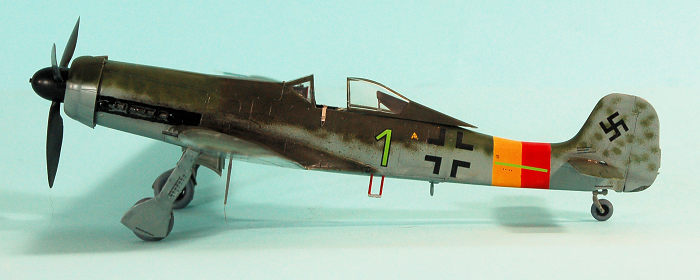 The Stabschwarm
had returned from an escort mission for Fw-190A-8s of the Gruppe, when two
RAF Tempests were spotted nearby attacking the Ludwigslust railyard.
Oberstleutnant Aufhammer, and Oberfeldwebels Sattler and Reschke took off to
catch the Tempests. Reschke recalled:
The Stabschwarm
had returned from an escort mission for Fw-190A-8s of the Gruppe, when two
RAF Tempests were spotted nearby attacking the Ludwigslust railyard.
Oberstleutnant Aufhammer, and Oberfeldwebels Sattler and Reschke took off to
catch the Tempests. Reschke recalled:
“Flying in number three position, I witnessed Oberfeldwebel Sattler dive into the ground seconds before we reached the Tempests. Now it was two against two.
“We knew the Tempest to be very fast, but here in a fight that never topped 50 meters, speed would not play a big part. The machine’s ability to turn would be all-important. At this altitude, neither of us could afford to make the slightest mistake, and for the first time since flying the Ta-152 I began to fully appreciate what this machine could do.
“Pulling ever-tighter turns, I got closer and closer to the Tempest, never once feeling I was even approaching the limit of the Ta-152's capabilities. The Tempest pilot was being forced to take increasingly dangerous evasive action. When he flicked over onto his opposite wingtip, I knew his last attempt to turn inside me had failed.
“My first burst of fire caught the Tempest in the tail and rear fuselage. The airplane shuddered and as an instinctive reaction the pilot immediately yoked into a starboard turn, giving me an even greater advantage.
“Now there was no escape for the Tempest. I fired again, but after a few rounds my guns fell silent. Fortunately, the Tempest pilot didn’t realize my predicament. He continued desperately totwist and turn and I positioned myself so I was always just within his field of vision. Eventually - inevitably - he stalled. The left wing dropped and he crashed into the4 woods immediately below us.”
The final victims of the Ta 152 were Soviet Yak-9s around Berlin on April 30, 1945. Approximately 150 Ta 152 H-1 fighters were manufactured between January 1, 1945 and the arrival of Soviet forces at the Cottbus assembly plant. While there were likely no more than 55 operational Ta-152H's, there were never more than about 24 serviceable at one time.
| THE KIT |
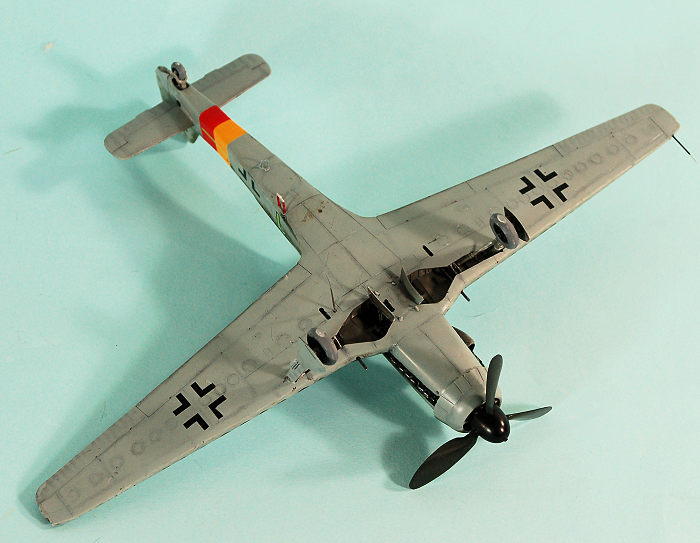 Trimaster originally released the Ta-152H kit in 1990, as part of the
Fw-190 kits released then. With the demise of Trimaster, the kits were released
by Dragon, and have also been released by Italerei at various times over the
past 20 years. This particular kit, released as part of Dragon’s Master Series,
was a special kit done for the Dragon Expo held in Virginia Beach back in 2008
that saw the first display of the dreadful 1/32 P-51D kit.
Trimaster originally released the Ta-152H kit in 1990, as part of the
Fw-190 kits released then. With the demise of Trimaster, the kits were released
by Dragon, and have also been released by Italerei at various times over the
past 20 years. This particular kit, released as part of Dragon’s Master Series,
was a special kit done for the Dragon Expo held in Virginia Beach back in 2008
that saw the first display of the dreadful 1/32 P-51D kit.
This is one of the few releases since the original Trimaster release to include the full Jumo 213E engine, which is why I decided to spend $25 on it rather than pick up the $20 Italerei kit that did not have the engine sitting beneath this one on the estate sale shelves at my local hobby shop here in the San Fernando Valley. The kit includes decals for “Green 1" and “Green 9" of the JG 301 Stabschwarm. Nominally, “Green 1" was assigned to Geschwaderkommodore Aufhammer, but it was allegedly being flown by Willi Reschke in his April 14, 1945 fight with the RAF Tempest.
| CONSTRUCTION |
I started with the engine, and quickly figured out why it had not been
part of the later releases of this kit. The parts don’t fit well! I soon decided
against my initial thought of using the open cowling panels in the kit to
display the engine, and decided to just have “something in there” to be seen
through the open wheel wells.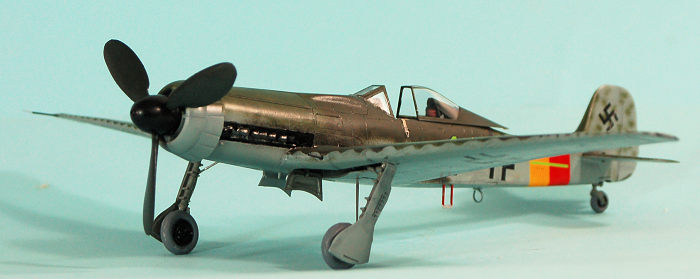
Once the engine was assembled and painted, I set about assembling the cockpit and attaching it to the fuselage half. With engine and cockpit mounted, I closed up the fuselage.
I then assembled the wings and joined the fuselage and wing sub-assemblies. Fit here was excellent and there were no gaps or seams anywhere around the wing/fuselage joints.
After looking at the kit canopy, I decided to use the “blown” canopy that had been included in the Eduard Fw-190a-5 kit, since it was from a much later period of mold technology and was nice and thin, and fully clear. I used the “slid open” option.
| COLORS & MARKINGS |
I went along with the kit instructions, for a camouflage of RLM 81/82 on the upper surfaces and RLM 76 on the lower surfaces. I used a mixture of Tamiya “Olive Drab” and “NATO Brown” for the RLM 81, and Tamiya “NATO Green” for the RLM 82, with my mixture of Tamiya “Light Blue” and “Light Grey” for the RLM 76 color.
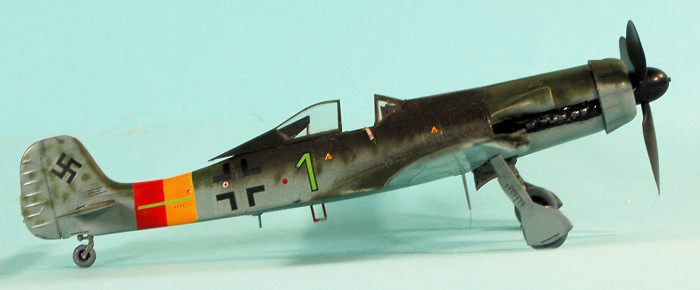 Since the kit supplied decals for the Reichverteidigung stripes, I
attempted to use those. When I discovered they wouldn’t meet along the
centerline, I stopped the decal work, masked off the rear fuselage, gave it a
coat of white followed by Tamiya Flat Yellow and Flat Red. After that, I
finished the decals, which went on without problems.
Since the kit supplied decals for the Reichverteidigung stripes, I
attempted to use those. When I discovered they wouldn’t meet along the
centerline, I stopped the decal work, masked off the rear fuselage, gave it a
coat of white followed by Tamiya Flat Yellow and Flat Red. After that, I
finished the decals, which went on without problems.
I gave the model an overall coat of Micro Clear Flat varnish, then attached the landing gear and prop, and unmasked the canopy. After fitting Eduard seat belts as though “thrown to either side” by the pilot, I attached the blown canopy in the open position.
| CONCLUSIONS |
The Dragon Ta-152H is closing in on 30 years, and to my mind it’s still the best kit of this airplane available. It’s far less fiddly than the SWS kit, and outside of the engine, everything fits easily.
21 June 2018
Copyright ModelingMadness.com
Review kit courtesy of the modeler who didn’t get around to it before his departure.
If you would like your product reviewed fairly and fairly quickly, please ontact the editor or see other details in the Note to Contributors.
Back to the Main Page Back to the Review Index Page Back to the Previews Index Page